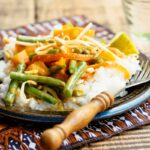Embark on a culinary adventure that’s both delicious and allergy-friendly! “Soy-Free Living Made Simple: Recipes Everyone Will Love” unveils a world of vibrant flavors and satisfying meals, expertly crafted to eliminate soy without sacrificing taste. Imagine a diverse menu bursting with breakfast delights, hearty lunches, comforting dinners, and decadent desserts, all meticulously designed to satisfy even the most discerning palates. Prepare to discover the secrets to effortlessly navigating a soy-free lifestyle, brimming with simple substitutions and clever techniques that will transform your kitchen into a haven of culinary creativity.
This comprehensive guide offers more than just recipes; it provides a complete toolkit for soy-free living. From stocking your pantry with essential soy-free staples to mastering soy-free cooking techniques and substitutions, you’ll gain the confidence and knowledge to create stunning meals with ease. Each recipe is detailed with vivid descriptions, ensuring you experience the full sensory journey—from the aroma of simmering chili to the satisfying texture of a perfectly baked cake. Prepare to be inspired, empowered, and delighted as you explore a world of culinary possibilities free from soy.
Essential Soy-Free Pantry Staples

Building a well-stocked soy-free pantry is the cornerstone of effortless and delicious soy-free cooking. Having these essential ingredients on hand allows for quick meal preparation and creative culinary exploration, ensuring you always have options for satisfying and healthy meals. This section details ten indispensable staples, their versatility, and inspiring ways to incorporate them into your soy-free repertoire.
Ten Essential Soy-Free Pantry Staples
A well-organized soy-free pantry, brimming with versatile ingredients, is the key to culinary freedom. These ten staples form the foundation for a wide range of delicious and healthy meals. Their diverse applications ensure that even the most demanding soy-free recipes are within easy reach.
- Olive Oil: A cornerstone of Mediterranean cuisine, olive oil provides healthy fats and a rich flavor. It’s perfect for sautéing, roasting, and drizzling over finished dishes.
- Coconut Oil: With its distinct aroma and high smoke point, coconut oil is ideal for high-heat cooking, baking, and adding a tropical twist to dishes.
- Rice (Brown & White): A versatile carbohydrate source, rice provides energy and serves as a base for countless dishes, from stir-fries to rice bowls.
- Quinoa: A complete protein and a nutritional powerhouse, quinoa is a delicious and healthy alternative to rice, perfect for salads, bowls, and side dishes.
- Lentils (Red & Green): These legumes are packed with protein and fiber, forming the heart of hearty soups, stews, and flavorful salads.
- Canned Beans (Black, Kidney, Chickpeas): Convenient and versatile, canned beans add protein and texture to salads, dips, soups, and chili.
- Oats (Rolled & Steel-Cut): Oats are a wholesome breakfast staple, but they also add texture and heartiness to baked goods, soups, and even savory dishes.
- Nuts & Seeds (Almonds, Walnuts, Chia Seeds, Flax Seeds): These provide healthy fats, protein, and fiber. They can be used as snacks, added to baked goods, or incorporated into salads and grain bowls.
- Spices & Herbs (Garlic Powder, Onion Powder, Paprika, Oregano, Basil): These add depth of flavor and aroma to any dish, enhancing both sweet and savory creations.
- Broth (Vegetable or Chicken): Broth forms the base of soups, stews, and sauces, adding flavor and moisture.
Creative Uses for Soy-Free Pantry Staples
The versatility of these pantry staples is truly remarkable. Each ingredient can be utilized in multiple ways, expanding your culinary horizons and preventing mealtime monotony.
Below are five creative applications for each of the ten essential soy-free pantry staples. These are merely suggestions; the possibilities are endless!
- Olive Oil: 1. Sauté vegetables. 2. Marinate chicken. 3. Make a vinaigrette. 4. Drizzle over pasta. 5. Add to homemade bread.
- Coconut Oil: 1. Stir-fry tofu (soy-free). 2. Bake cookies. 3. Make coconut milk ice cream. 4. Add to curry. 5. Use as a hair mask.
- Rice (Brown & White): 1. Rice bowls. 2. Sushi. 3. Rice pudding. 4. Fried rice. 5. Stuffing.
- Quinoa: 1. Quinoa salad. 2. Quinoa bowls. 3. Quinoa burgers. 4. Quinoa porridge. 5. Add to soups.
- Lentils (Red & Green): 1. Lentil soup. 2. Lentil stew. 3. Lentil loaf. 4. Lentil salad. 5. Add to veggie burgers.
- Canned Beans (Black, Kidney, Chickpeas): 1. Chili. 2. Hummus. 3. Bean salad. 4. Bean burritos. 5. Add to soups and stews.
- Oats (Rolled & Steel-Cut): 1. Oatmeal. 2. Oat cookies. 3. Oat flour for baking. 4. Add to smoothies. 5. Use as a breading for meat.
- Nuts & Seeds (Almonds, Walnuts, Chia Seeds, Flax Seeds): 1. Snack. 2. Add to baked goods. 3. Make nut butter. 4. Sprinkle on salads. 5. Add to smoothies.
- Spices & Herbs (Garlic Powder, Onion Powder, Paprika, Oregano, Basil): 1. Season meats. 2. Flavor vegetables. 3. Make spice rubs. 4. Add to sauces. 5. Infuse oils.
- Broth (Vegetable or Chicken): 1. Soup base. 2. Stew base. 3. Sauce base. 4. Risotto base. 5. Deglaze pan after searing meat.
Soy-Free Cooking Techniques & Substitutions
Embarking on a soy-free journey doesn’t mean sacrificing flavor or culinary creativity. This section explores common soy-based ingredients, their effective replacements, and how to seamlessly integrate these substitutions into your favorite recipes, resulting in delicious and satisfying soy-free meals. We’ll delve into practical techniques and provide detailed examples to empower you to confidently navigate the world of soy-free cooking.
Soy Sauce Alternatives
Soy sauce, a staple in many cuisines, provides umami depth and salty tang. However, it’s fundamentally soy-based. Fortunately, several excellent alternatives exist, each offering a unique flavor profile. Coconut aminos, derived from coconut sap, boast a subtly sweet and savory taste, slightly less salty than soy sauce. Tamari, a wheat-based soy sauce, is a viable option for those with mild soy sensitivities, but it’s not completely soy-free. For a completely soy-free option with a bolder, more intense flavor, consider using a mushroom-based seasoning or a blend of tamari and coconut aminos. These substitutions can easily enhance the flavor profiles of stir-fries, marinades, and dipping sauces. The visual difference is subtle; all three are dark brown liquids, but the coconut aminos tend to have a slightly lighter, almost translucent quality compared to the darker hues of tamari and mushroom-based seasonings.
Soy Milk Substitutions
Soy milk, a popular plant-based milk, offers a creamy texture and mild flavor in many recipes. However, for soy-free cooking, various alternatives provide similar functionality and often unique taste dimensions. Almond milk, with its subtly nutty notes, works well in smoothies, baked goods, and creamy sauces. Oat milk, known for its creamy texture and slightly sweet taste, is a versatile option suitable for coffee, cereal, and even in savory dishes. Rice milk, though thinner in consistency, provides a neutral backdrop for dishes where a mild flavor is preferred. The visual difference is noticeable; almond milk often has a slightly opaque, almost cloudy appearance, while oat milk can be slightly thicker and creamier. Rice milk is typically the thinnest and most translucent.
Tofu Substitutions
Tofu, a versatile soy-based protein source, adds texture and substance to many dishes. Finding a suitable replacement depends on the desired outcome. For similar texture in stir-fries or curries, firm or extra-firm chickpeas or lentils, properly prepared, offer a comparable consistency and absorb flavors well. For applications where a softer texture is preferred, such as in vegan burgers, a blend of cooked mushrooms, lentils, and breadcrumbs can mimic tofu’s malleability. Visually, chickpeas and lentils offer a more visible, speckled texture compared to the smooth, almost uniformly white appearance of tofu. The mushroom and lentil mixture takes on a more heterogeneous appearance, reflecting the varied ingredients.
Adapting Recipes: Three Soy-Free Makeovers
This section demonstrates how to adapt three popular recipes to be completely soy-free, highlighting the flavor profiles achieved through thoughtful substitutions.
Soy-Free Pad Thai
Traditional Pad Thai relies heavily on soy sauce and often includes soy-based fish sauce. A delicious soy-free version substitutes coconut aminos for the soy sauce and fish sauce, imparting a subtly sweet and savory flavor profile. The addition of lime juice and tamarind paste balances the sweetness and adds complexity. The visual effect is similar, retaining the vibrant colors of the noodles, vegetables, and protein, but the flavor profile is distinctly different, offering a more tropical twist.
Soy-Free Stir-Fry
Many stir-fries utilize soy sauce for its umami richness. Replacing soy sauce with a mushroom-based seasoning creates a deeply savory and earthy flavor. The addition of ginger, garlic, and other aromatics further enhances the overall taste, while the slight sweetness of coconut aminos can be used to balance the dish. Visually, the stir-fry retains its colorful appeal, with the various vegetables and proteins brightly presented.
Soy-Free Vegan Chili
Traditional vegan chili recipes often include soy-based ingredients for thickening and added protein. Replacing these with lentils or white beans not only provides a similar thickening effect but also adds hearty texture and protein. The result is a rich, flavorful chili that is both satisfying and hearty. Visually, the chili maintains its rich, dark color, but the texture may be slightly more substantial due to the lentils or beans.
Preparing a Simple Soy-Free Meal: A Step-by-Step Guide
This guide demonstrates the preparation of a simple soy-free meal, highlighting key techniques for success. The recipe focuses on a quick and easy stir-fry, showcasing the ease and efficiency of soy-free cooking.
Prepare the vegetables: Chop your chosen vegetables (broccoli, carrots, peppers, etc.) into bite-sized pieces.
Marinate the protein: If using protein (chicken, tofu alternative, etc.), marinate it in a mixture of coconut aminos, ginger, and garlic for at least 15 minutes.
Stir-fry: Heat a wok or large skillet over medium-high heat. Add a little oil (coconut oil or avocado oil work well) and stir-fry the vegetables until tender-crisp. Add the marinated protein and cook until thoroughly heated through.
Season: Stir in the coconut aminos, a pinch of red pepper flakes (optional), and any other desired seasonings. Serve over rice or quinoa.
This simple approach highlights how straightforward and enjoyable soy-free cooking can be. The vibrant colors of the vegetables and the aromatic spices create a visually appealing and flavorful meal.
With “Soy-Free Living Made Simple: Recipes Everyone Will Love,” you’re not just eliminating soy; you’re unlocking a universe of culinary creativity. This guide equips you with the knowledge, techniques, and delicious recipes to confidently embrace a soy-free lifestyle. From the vibrant colors and aromatic spices of our signature chili to the melt-in-your-mouth texture of our soy-free desserts, every recipe is designed to tantalize your taste buds and leave you feeling satisfied and inspired. More than just a cookbook, this is your passport to a healthier, more flavorful, and exciting culinary journey—one delicious, soy-free dish at a time.
Questions and Answers
Can I use soy sauce substitutes in all recipes?
While many soy sauce substitutes work well, some recipes might require adjustments based on the specific substitute’s flavor profile and salt content. Always check the recipe notes for recommendations.
Are all the recipes suitable for vegetarians/vegans?
Most recipes are vegetarian, but some might contain animal products. Check individual recipe descriptions for dietary information.
How long do the soy-free pantry staples last?
Storage times vary depending on the ingredient. Check individual product packaging for best-by dates and proper storage instructions.
Where can I find the soy-free ingredients?
Many soy-free ingredients are available at major grocery stores, health food stores, and online retailers. Check local stores or search online for specific items.


